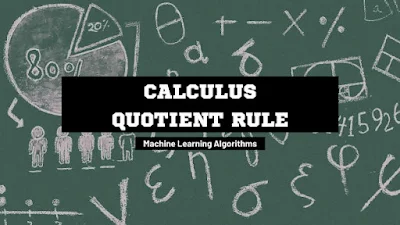Calculus Quotient Rule and Machine Learning Algorithms: Bridging the Gap
Introduction:
In the ever-evolving landscape of technology, the synergy between mathematical concepts and machine learning algorithms plays a crucial role in shaping innovative solutions. One such mathematical foundation that profoundly influences machine learning is calculus, specifically the quotient rule. This blog post explores the intersection of calculus quotient and its impact on the development and understanding of machine learning algorithms.
"Explore the symbiotic relationship between calculus quotient rule and machine learning algorithms in this insightful blog post. Dive into real-world examples illustrating how the quotient rule optimizes linear regression, logistic regression, neural networks, and support vector machines. Uncover the practical application of mathematical foundations in shaping cutting-edge technology and enhancing the performance of machine learning systems."
Understanding the Quotient Rule:
The quotient rule in calculus is a fundamental tool for differentiating functions that involve the division of one function by another. Mathematically, if we have a function
f(x) = g(x) / h(x),
the quotient rule states that the derivative f'(x) is given by
(g'(x) * h(x) - g(x) * h'(x)) / (h(x))^2.
Overcoming Challenges in Quotient Rule Applications
Dealing with Complex Functions
In some cases, functions involved in the Quotient Rule may be complex. Strategies for simplifying or breaking down complex functions are essential to ensure accurate derivative calculations.Addressing Indeterminate Forms
Indeterminate forms, such as 0/0, may arise during the application of the Quotient Rule. Techniques like L'Hôpital's Rule can be employed to resolve such indeterminate forms and obtain meaningful results.Advantages and Limitations of the Quotient Rule
Advantages
Versatility: The Quotient Rule accommodates a wide range of functions, providing a versatile tool for calculus practitioners.
Precision: When applied correctly, the Quotient Rule yields precise derivatives, crucial for accurate mathematical modeling.
Limitations
Complexity: The Quotient Rule may become intricate when dealing with functions involving multiple variables or intricate compositions.Domain Restrictions: The rule requires the denominator function g(x) to be nonzero, imposing domain restrictions on its application.
Real-world Examples: Applying the Quotient Rule
Example 1: EconomicsConsider a demand function D(x) representing the quantity demanded for a product, and a supply function S(x) indicating the quantity supplied. The equilibrium price, where demand equals supply, can be determined using the Quotient Rule.
Equilibrium Price= D(x)/S(x)
Example 2: Physics
In physics, the motion of an object subjected to air resistance involves complex equations. The Quotient Rule aids in finding the velocity and acceleration of the object, essential for predicting its behavior
How Quotient Rule Relates to Machine Learning:
In machine learning, understanding the derivative of a function is crucial for optimizing algorithms through techniques like gradient descent. The quotient rule, with its focus on the differentiation of ratios, becomes particularly relevant when dealing with complex models involving the division of functions.
Gradient Descent and Optimization:
Gradient descent is a widely used optimization algorithm in machine learning. It involves iteratively adjusting model parameters to minimize a cost function. The derivative, as computed using the quotient rule, guides this process by indicating the direction and magnitude of adjustments needed for optimal performance.
Neural Networks and Backpropagation:
Neural networks, a cornerstone of machine learning, heavily rely on backpropagation for training. Backpropagation is essentially the application of the chain rule and, by extension, the quotient rule. It calculates gradients with respect to the network's parameters, facilitating the adjustment of weights and biases during training.
Case Study:
Linear Regression:
Consider a simple linear regression model represented by the equation
y = mx + b.
The goal is to minimize the mean squared error (MSE) to obtain the optimal values for the slope (m) and y-intercept (b). The derivative of the MSE involves the quotient rule, guiding the gradient descent algorithm in adjusting these parameters for improved model performance.
Logistic Regression and the Sigmoid Function
Logistic regression is a classification algorithm that uses the sigmoid function to map input values to a probability range between 0 and 1. The derivative of the sigmoid function, a key component in logistic regression, relies on the quotient rule. This derivative is crucial for updating weights during training through techniques like gradient descent, ensuring accurate predictions in binary classification tasks.
Support Vector Machines (SVM)
Support Vector Machines are widely used for classification and regression tasks. The optimization process involves finding the optimal hyperplane that maximizes the margin between classes. The gradient of the SVM objective function, which includes a quotient term, is crucial for guiding the SVM algorithm in finding this optimal separation.
Conclusion:
In the realm of machine learning, the profound connection between calculus quotient and algorithmic optimization underscores the importance of a strong mathematical foundation. As we continue to push the boundaries of what's possible with technology, understanding these mathematical underpinnings becomes not just a theoretical exercise but a practical necessity for building robust and efficient machine learning systems. The quotient rule, with its elegance and applicability, stands as a testament to the symbiotic relationship between mathematics and cutting-edge technologies.


Comments
Post a Comment